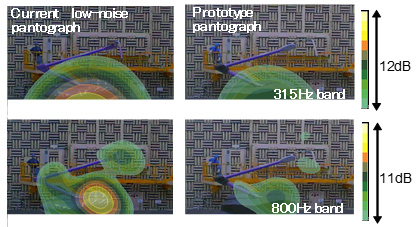Newsletter 2020.3 Index
Theme : "The Conference of Fluid Engineering Division (March issue)”
|
Wind Tunnel Tests for Research and Development of Trains
Atsushi IDO Railway Technical Research Institute
|
Abstract
Aerodynamics and aeroacoustics are sources of environmental and safety subjects of trains. Several methods aimed at analyzing and understanding the subjects have been proposed, including the use of wind tunnel tests and on track tests as well as CFD. In 1996, the Railway Technical Research Institute (RTRI) constructed a large scale low noise wind tunnel to study the aerodynamic properties and aerodynamic noise of the trains. We report on the use of the investigative wind tunnel test techniques to study the aerodynamic noise reduction of a pantograph, the safety of the railway vehicle in cross winds and the aerodynamic drag reduction of trains.
The aerodynamic noise of the high-speed trains is one of the most important problems from an environmental point of view, and the pantograph is one of the aerodynamic noise sources around the trains. We carried out the wind tunnel tests to reduce the aerodynamic noise of the pantograph (Fig.1). In the wind tunnel tests, we use a microphone array to clarify the noise sources at each frequency. As a results of wind tunnel tests, we can reduce the aerodynamic noise of the pantograph efficiently.
Another subject of great importance is the running safety of railway vehicle in cross winds. We must be able to accurately estimate the aerodynamic forces of vehicles. Previous studies have established that these forces were affected by the configuration of the vehicles, the railway structures and the conditions of velocity profiles. When the wind tunnel tests were performed, we reproduced the natural wind and set various train models on the various railway structure models in the test section (Fig.2). From the results, we were able to accurately estimate the aerodynamic coefficients and the effectiveness of windbreak fences.
As a train runs at higher speed, aerodynamic drag becomes larger. It is important to reduce it from the viewpoint of energy saving. Previous researches show that, to reduce the aerodynamic drag, it is the most effective to smooth the vehicle surface. We propose the method to estimate the aerodynamic drag reduction of trains. To improve the accuracy of the estimation, we have to reproduce the flow between the underside and the ground accurately by using spires attached to vehicle in addition to boundary layer suctions and a mobbing belt (Fig.3).
We performed the various wind tunnel tests for trains. It is important to adopt the suitable wind tunnel test technique for the purpose of each research. The wind tunnel tests will be more useful methods for studying the train aerodynamics.
Key words
Wind tunnel test, Train, Aerodynamic noise, Noise source identification, Cross winds, Aerodynamic drag
Figures

(a) Layout of experimental apparatus.

(b) Noise source distribution map.
Fig. 1 Noise source identification by microphone array.

Fig. 2 Aerodynamic characteristics measurement in cross winds.

Fig. 3 Aerodynamic drag measurement of an intermediate vehicle.


